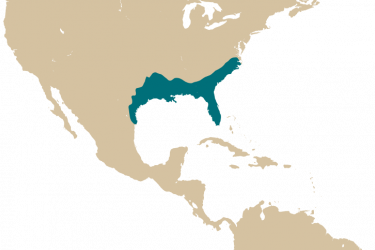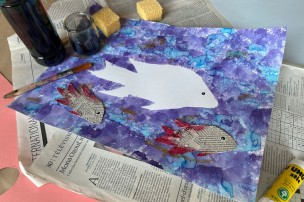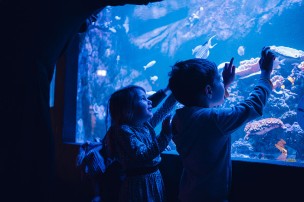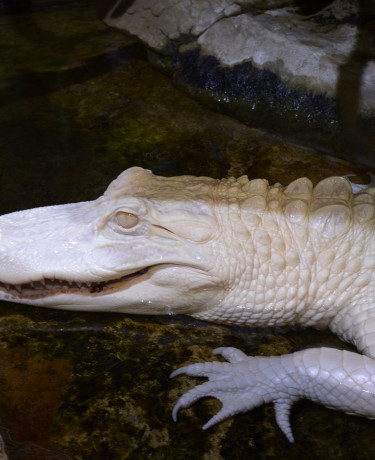
Albino alligator
Alligator mississippiensisIn February 2014, the Aquarium has welcomed two young albino alligators. It can thus offer its visitors a unique opportunity to discover this rare specimen. The rarity of this animal relates to the laws of genetics since each of the two parents must carry the genes responsible for albinism.
Albinism
The purpose of genes, the DNA segments that constitute chromosomes, is to implement the production of various proteins that will play a vital role from the fertilisation stage. A gene is said to “code” for a specific function. Sometimes the machine gets jammed for different reasons and the code is wrong, and we refer to this as a mutation. If the mutation occurs in the vital elements of development, everything will stop. Some mutations however will not prevent life from forming but will, on the other hand, alter a particular function. That is the case for the genes that code for an enzyme, tyrosinase, which intervenes in melanin, the pigment present in the skin cells, hair or iris. Albinos are characterised by a very pale skin (no melanin in the melanocytes), depigmentation of the hair and blue to grey irises with a near-red reflection.
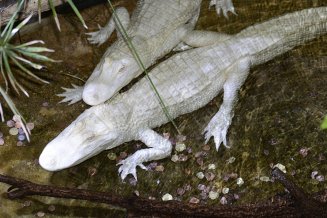
Legende
Les deux alligators albinos femelles de l'Aquarium.
Credit
Photo : Déodat Manchon @ Palais de la Porte Dorée
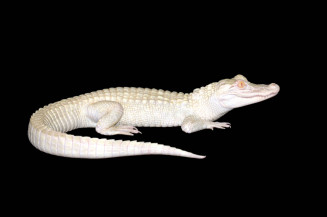
Alligator du Mississippi albinos
The Crocodilians at the Tropical Aquarium
The Tropical Aquarium at the Porte Dorée also tells a story of great loyalty created around one of the finest crocodile pits in Europe. The pit was created in 1934 with a décor that was unprecedented at the time in an animal park, with an initial population of crocodiles. In 1948, Théodore Monod, scientist, naturalist and explorer for the Muséum National d’Histoire Naturelle sent a new group of Nile crocodiles (Crocodylus niloticus) from Dakar, thus sparking the legend of the “croc pit” in visitors’ imaginations. The very last of these crocodiles, who arrived in 1948 as adults, lived until 2008. So for 60 years, several generations of visitors have faithfully returned over and over again to see these emblematic residents of the Tropical Aquarium.
In 2008, the Aquarium decided to display some Mississippi alligators (Alligator mississippiensis), other crocodilians born at La Ferme aux Crocodiles in Pierrelatte. The three young females (3 sisters) have made themselves at home here and enjoy the daily care they receive, alternating baths, showers or relaxing on the beach. Reputed to be less aggressive than Nile crocodiles, these alligators are nevertheless wild animals who can make it very clear, through appropriate vocalizations, that you are not welcome on their territory.
Crocodilians, the name given to this order of reptiles, include 3 families and 27 species. As carnivores, alligators are oviparous like birds and in fact are not far from them on the great phylogenetic tree representing the various links or relationships between the different groups of living things. Unlike crocodiles who dig a nest in the ground, female alligators lay their eggs in mounds of decomposing leaves, and the temperature gradient in the nest will determine the gender of the newborn. After birth, the female will take care of her offspring, manipulating her little ones in her formidable jaws, transporting them on her back to cross the backwater. Although all species of crocodilians – alligators, caimans, crocodiles or gavials – are protected by the Washington Convention governing the wildlife trade (CITES), Mississippi Alligators are not the most endangered. Nowadays, hunting is not the biggest factor impacting wild populations in Louisiana or Florida, but rather pollution and loss of surface area in their natural habitat. The animals on display at the Tropical Aquarium are the result of protection programmes that are helping to preserve a diverse genetic heritage, indispensable to successful species protection. But genetics, or rather genes, sometimes play tricks on nature. The appearance of albinos in the different groups of vertebrates is a visible demonstration of this. Albinism explained in a video
